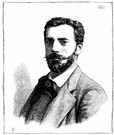The
Building of the Statue of Liberty
The Statue of Liberty was a gift from France and was dedicated on October 28, 1886, on Liberty Island in New York Harbor. The Statue and the island on which it sits have varied histories.
What we now call Liberty Island was originally called Minnissais by the Mohegan Native American tribe; to them, this meant "Lesser Island." English settlers laid claim to the island in 1664 and changed its name to Oyster Island. In the struggle between England and the Netherlands, England sold the island to Issack Bedloo, a New Amsterdam businessman, in 1668. Bedloo called it Love Island. Bedloo died a few years later, but his name became attached to the island, as New Yorkers and Americans who lived there and near there called it Bedloe Island for years. In fact, it wasn't until 1960 that the island got its current name of Liberty Island.
The Statue of Liberty was essentially a gift from France to the United States as a symbol of the bond that the two nations forged during the American Revolutionary War, but it took a lot of building and fund-raising to get the job done.
 A French sculptor named Auguste Bartholdi was put in charge of building the massive statue. He was helped immensely by the engineer Alexandre Eiffel (the man who built the Eiffel Tower), who designed the statue's copper skin to move ever so slightly in the wind yet not enough to come loose from its steel frame. (Indeed, it sways, the entire statue as much as 3 inches in a 50mph wind.)
A French sculptor named Auguste Bartholdi was put in charge of building the massive statue. He was helped immensely by the engineer Alexandre Eiffel (the man who built the Eiffel Tower), who designed the statue's copper skin to move ever so slightly in the wind yet not enough to come loose from its steel frame. (Indeed, it sways, the entire statue as much as 3 inches in a 50mph wind.)
The pedestal was built here in the U.S., largely using donated money. New York World publisher Joseph Pulitzer was instrumental in helping raise money to complete this project.
 The statue was completed in 1884, then amazingly dismantled for shipping across the Atlantic Ocean. The 152-foot-tall statue was taken apart into 350 pieces and placed in 219 crates. The French ship Isere transported the statue's parts to New York in 1885, the same year that the pedestal was complete. It took several months of reconstruction and "final touches," but the statue was finally unveiled on October 28, 1886, to the satisaction and relief of people on both sides of the Atlantic. Both nations had hoped to unveil the statue in New York harbor in 1876, to celebrate the 100th anniversary of the Declaration of Independence. Delays in construction and funds pushed the celebration back 10 years.
The statue was completed in 1884, then amazingly dismantled for shipping across the Atlantic Ocean. The 152-foot-tall statue was taken apart into 350 pieces and placed in 219 crates. The French ship Isere transported the statue's parts to New York in 1885, the same year that the pedestal was complete. It took several months of reconstruction and "final touches," but the statue was finally unveiled on October 28, 1886, to the satisaction and relief of people on both sides of the Atlantic. Both nations had hoped to unveil the statue in New York harbor in 1876, to celebrate the 100th anniversary of the Declaration of Independence. Delays in construction and funds pushed the celebration back 10 years.
At the dedication ceremony, a poet named Emma Lazarus read a poem that she wrote. This poem, called "New Colossus," has come to symbolize Lady Liberty. The text of the poem is below.
The New Colossus
Not like the brazen giant of Greek fame,
with conquering limbs astride from land to land;
Here at our sea-washed, sunset gates shall stand
a mighty woman with a torch, whose flame
is the imprisoned lightning, and her name
Mother of Exiles. From her beacon-hand
Glows world-wide welcome; her mild eyes command
The air-bridged harbor that twin cities frame,
"Keep, ancient lands, your storied pomp!" cries she
with silent lips. "Give me your tired, your poor,
Your huddled masses yearning to breathe free,
The wretched refuse of your teeming shore,
Send these, the homeless, tempest-tost to me,
I lift my lamp beside the golden door!"